Abstract
Salt efflorescence is always a main barrier for pottery cultural relic conservation. This study presents an innovative two-step process for enhancing the reinforced strength of efflorescence pottery. The first step involves forming a cross-linked mesh structure on the weathered surfaces using ethyl orthosilicate hydrolysate as an organic reinforcement material. In the second step, a two-component inorganic reinforcement material is developed to transform the destructive salt into a filling reinforcement material. The reinforcement pottery was comparatively investigated by XRD, color difference analysis, penetration depth measurements, mechanical strength tests, permeability assessment, and surface morphology characterization. The results demonstrate that the optimized reinforcement material exhibits high water permeability (up to 2.5 cm in penetration depth), stable color variation (ΔE up to 1.44), and excellent mechanical properties (17.01 MPa compressive strength and 2.66 MPa flexural strength). This work presents a promising technique for enhancing the structural interlocking between reinforcement pottery, which is crucial for mitigating dominant salt damage, and suggests an effective strategy that is applicable to the protection of cultural relics.
1. Introduction
Archeological excavations in China unearth tens of thousands of pottery fragments annually. The emergence of pottery marked the beginning of the Neolithic Age, and it constitutes an irreplaceable component of global historical and cultural heritage. Pottery is typically fabricated from coarse clay via low-temperature firing (700 °C–1000 °C), resulting in a porous matrix with heterogeneous pore size distributions that critically compromise its structural durability []. However, antique pottery is vulnerable to both environmental stressors and intrinsic material defects, which synergistically induce surface weathering and structural degradation []. Prolonged burial pottery is exposed to soil moisture and soluble salts, and these salts undergo cyclic dissolution and recrystallization driven by hydrological fluctuations, generating crystallization pressure within the matrix that culminates in internal structural failure. Concurrently, salt migration via capillary action results in efflorescence: as water evaporates, salts precipitate on surfaces, forming expansive crystals that induce powdering and spalling pathologies [,]. Therefore, developing effective reinforcement strategies for ancient ceramics constitutes both a scientific imperative and a cultural preservation emergency [,,,].
With the continuous advancement of cultural relics protection and restoration practices, research on pottery conservation technologies has also made great progress. Existing reinforcement materials are mainly classified into inorganic materials and organic compounds. Common inorganic materials such as calcium hydroxide and barium hydroxide are low-cost, easy to operate, and stable over time. However, they generally lack the mechanical strength and essential penetration in the application [,,]. In contrast, organic materials—particularly silicone-based compounds and acrylic resins (such as Primal AC33 and B72) [] and ethyl orthosilicate (TEOS) [,,]—exhibit superior penetration capabilities and mechanical reinforcement properties. However, these organic materials may induce significant surface discoloration due to photodegradation and chemical interactions of the ceramic substrate [,,]. Researchers have found that inorganic materials and organic materials individually exhibit their pros and cons, which has propelled the emergence of combined organic–inorganic composites as a promising strategy. For example, Kali Kapetanaki et al. [] developed a non-toxic protective colloidal material using TEOS, polydimethylsiloxane, and calcium oxalate nanoparticles as raw materials, which demonstrates excellent physical properties and hydrophobicity. Similarly, Liu Y et al. [] prepared a TEOS/ polydimethylsiloxane (PDMS)/F 127 composite to reinforce Dazu stone carving sandstone samples, which significantly enhances their relative aging resistance and mechanical properties. Nevertheless, the fabrications of those reinforced composites with comprehensive excellent performance still remain a technical challenge.
Herein, TEOS and CB (a mixture of H2C3O4, Ba(OH)2·8H2O, and H3PO4) were employed as raw reactants to enhance the mechanical integrity of the pottery by exploiting the complementary advantages of organic and inorganic components [,,,]. TEOS, an organosilane compound, is characterized by a Si-O-Si backbone structure that provides thermal and chemical stability comparable to conventional polymers [,,,]. Furthermore, the presence of Si-C bonds in organosilanes enables the incorporation of diverse organic groups, allowing functionalities such as deacidification [], hydrophobicity [], and antimicrobial effects []. The CB component interacts with intrinsic substances in pottery to form insoluble salts (such as BaCO3, CaC2O4, and Ba3(PO4)2), which enhance cross-linking of inorganic minerals within the ceramic matrix [,,,,]. A series of TEOS/CB hybrid materials were synthesized through a two-step process. The compatibility and mechanical properties of the materials were assessed through a series of tests, including permeability, compressive strength, flexural strength, water vapor transmission rate, and colorimetric analysis. The protective mechanism was further elucidated by way of microanalysis methods such as XRD and scanning electron microscopy. These investigations collectively validated the holistic efficacy of the materials in reinforcing and preserving pottery artifacts.
2. Materials and Methods
2.1. Chemicals and Reagents
All chemicals of analytically pure grade were purchased from Sinopharm Chemical Reagent Co., Ltd. (Shanghai, China), including ethyl orthosilicate (TEOS, 99.9%), ethanol (C2H5OH, ≥99.7%), methanol (CH3OH, ≥99.5%), barium hydroxide octahydrate [Ba(OH)2·8H2O, 98%], oxalic acid (H2C2O4, ≥99.6%), phosphoric acid (H3PO4, 85% aqueous solution), and sodium chloride (NaCl, ≥99.5%).
2.2. Preparation and Firing of Simulated Pottery
All clay used in the experiment was sourced from Jingdezhen City, Jiangxi Province. Impurities such as gravel and organic residues were removed using an 80-mesh standard sieve with a 0.45 mm aperture. The clay was then mixed with water at a 3:1 ratio and kneaded repeatedly to expel air from the adobes. To prevent air holes, the pottery surface was smoothed with wet hands during kneading. The moistened clay was placed in a 0.5 cm × 5 cm × 10 cm rectangular mold, lightly shaped, and then removed to dry slowly indoors in the shade. A layer of newspaper was placed on top to protect it from direct sunlight and collisions. Once dried, the pottery was fired in a furnace according to the following specific firing curve:
Step 1: Heat from 25 °C to 200 °C over three hours.
Step 2: Heat from 200 °C to 500 °C over two hours.
Step 3: Raise the temperature to a maximum of 700 °C, heat from 500 °C to 700 °C over one hour, and then hold at 700 °C for one hour.
Step 4: After holding, allow the furnace to cool below 40 °C before removing the pottery.
2.3. Synthesis of Reinforcing Agents
2.3.1. Preparation of Ethyl Orthosilicate Hydrolysates
Ethyl orthosilicate was added at volume fractions of 10%, 20%, 30%, 40%, and 50% to a beaker containing ethanol, and the mixture was sealed with polyethylene film to prevent solvent evaporation. The mixture was then stirred magnetically at 25 °C for 2 h until a homogeneous colorless solution formed. After confirming the absence of precipitates via visual inspection, the solution was collected and stored at 25 °C for subsequent use. This solution is hereafter referred to as the pretreatment solution.
2.3.2. Preparation of CB Two-Component Inorganic Reinforcing Agent
Composition I: Oxalic acid (20 g) and phosphoric acid (10 g) were dissolved in 1000 mL of ethanol under continuous magnetic stirring (Shanghai Sile Instruments Co., Ltd., Shanghai, China) at 40 °C for 30 min to obtain a colorless homogeneous solution. This solution is hereafter referred to as CB I.
Composition II: Barium hydroxide octahydrate powder (15 g) was dispersed in 1000 mL of methanol and subjected to reflux condensation at 80 °C for 5 h using a standard reflux apparatus (Sichuan ShuBo, Chengdu, China). After cooling to 25 °C, the pH was adjusted to 9.0 by adding methanol dropwise. The final solution was transferred to a nitrogen-purged sealed container to prevent carbonate formation. This solution is hereafter referred to as CB II.
2.4. Reinforcement Process
Step 1: Soak the pottery sample in a 10% NaCl solution under controlled conditions, then dry it once salt damage appears.
Step 2: Saturate the surface with pretreatment solution by slow dripping, seal with cling film, and dry naturally.
Step 3: Apply CB I, a reinforcing agent, in the same manner.
Step 4: Repeat with the CB II reinforcing agent on the surface from Step 3.
Repeating Steps 3 and 4 once produces CB (1), and twice produces CB (2). The full reinforcement process is shown in Figure 1, with treated samples shown in Figure 2.
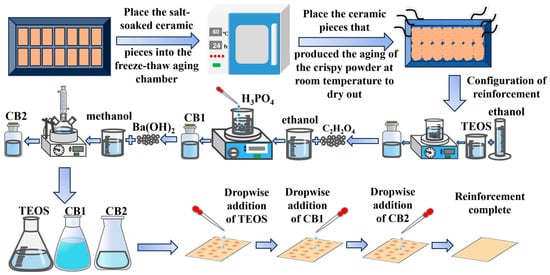
Figure 1.
Preparation of reinforcement and reinforcement process.
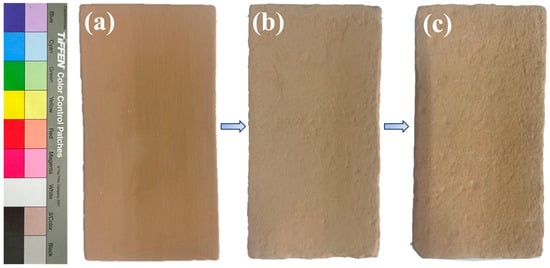
Figure 2.
(a) Untreated samples; (b) salt-aged samples; and (c) reinforced samples.
2.5. Characterization
The consolidated samples were ground into powder with a mortar and pestle and characterized using a Rigaku Mini Flex 600 X-ray diffractometer (Rigaku Corporation, Tokyo, Japan). The parameters were set as follows: the tube voltage was set at 30 kV, the tube current was set at 15 mA, and the scanning angle range was 10°–80° with a step size of 0.02°. For scanning electron microscopy analysis, the samples were immobilized on the conductive adhesive plate and then coated with a gold layer via ion sputtering for 120 s. Morphology analysis was performed using a Hitachi SU3500 tungsten-filament scanning electron microscope (Hitachi, Tokyo, Japan) with the following specifications: a secondary electron resolution of 3 nm at 30 kV and 7 nm at 3 kV; a backscattered electron resolution of 4 nm at 30 kV and 10 nm at 5 kV; and a magnification up to 1000 fold.
2.5.1. Colorimetric Analysis
The colorimetric analysis was performed using an X-Rite VS450 spectrophotometer (manufactured by X-Rite Incorporated, Grand Rapids, MI, USA). The original brightness (L*), red–green (a*), and yellow–blue (b*) coordinates of the sample surfaces were measured in their natural state. The reinforcement treatment was applied until constant weight was achieved, and the chromaticity values were remeasured to quantify the color difference (DE*). Three measurement points were selected for each sample, and the average values were calculated [,]. The total color change was determined by Equation (1):
where ΔL* is the brightness difference, which indicates the black–white deviation, Δa* is the red–green deviation, and Δb* is the yellow–blue deviation. A smaller DE* value indicates less noticeable color variation is found after reinforcement treatment.
2.5.2. Penetration Testing
Permeate solutions of specific component concentrations were prepared according to experimental protocols. Simulated specimens were inverted (bottom side down) and positioned on a wire mesh support within Petri dishes. The dishes were then filled with different permeation solutions, ensuring the liquid level was 2 mm above the specimen surface. Capillary rise height was monitored using a digital stopwatch, with measurements recorded at 5-min intervals. After 60 min of continuous permeation, the maximum height of the rise in the capillary was determined as the absorption capacity indicator.
2.5.3. Air Permeability Test
A ceramic sample was placed on a 50 mL beaker containing distilled water, and the interface was sealed with adhesive to prevent air leakage. The setup was weighed for its initial mass, and then kept at a constant temperature and humidity. Mass was remeasured every 24 h, and permeability was evaluated from cumulative water loss.
2.5.4. Compressive Strength Test
The sample block’s dimensions were measured, and then the specimen was secured in a universal testing machine and subjected to a constant stress–displacement test until fracture or disintegration. Compressive strength was calculated using Equation (2).
where refers to the compressive strength of the stone (MPa); P stands for maximum load at failure (N); and A denotes the cross-sectional area of the sample (mm2).
2.5.5. Flexural Strength Test
The samples were dried in an oven at 110 °C for 2 h and subsequently cooled to room temperature in a desiccator. Prior to testing, the diameter and height of each sample were measured and recorded. The specimen was then secured in the flexural test fixture of a universal material testing machine (Instron, Boston, MA, USA). A uniformly distributed force was applied through the instrument at a constant probe displacement rate of 5 mm/min (downward direction) until fracture occurred. The flexural strength was calculated using three-point bending:
where P stands for maximum load at fracture (N); L stands for fixture span (mm); b stands for sample width at fracture (mm); and d stands for sample thickness at fracture (mm).
3. Results and Discussion
3.1. Phase Structure Analysis and Surface Micro-Morphological Analysis
When applying scientific methods to preserve cultural relics, the impact on the relics themselves should be minimized as much as possible. This principle dictates that the material composition of ceramic substrates should be maintained without significant alterations, and any detectable changes in crystalline phases should be carefully monitored as key indicators of evaluating reinforcement efficacy. The XRD patterns of all samples are depicted in Figure 3. The analysis revealed that no substantial phase transformation was observed in the samples before and after reinforcement. Specifically, the primary peak positions (2θ values) of the four samples remain consistent, indicating that the reinforcing agents did not disrupt the fundamental crystalline structure of the ceramic matrix. Additionally, the dominant diffraction peaks correspond to crystalline SiO2 phases, confirming the stability of the primary components. These observations collectively demonstrate that modified materials undergoing reinforcement have hardly affected the cultural heritage substrate, aligning with heritage conservation principles that emphasize structural integrity preservation and the use of reversible treatments.
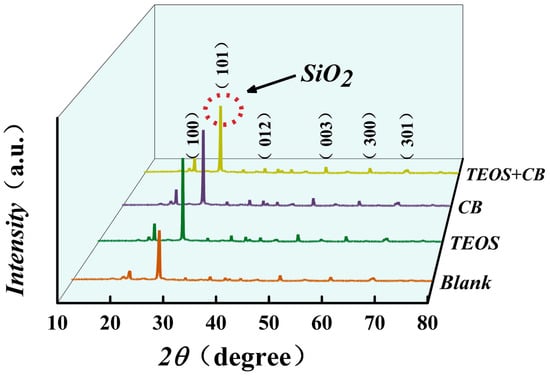
Figure 3.
XRD pattern for all the prepared samples with different reinforcements.
In this study, a scanning electron microscope was utilized to systematically compare the microstructural evolutions of samples undergoing different reinforcement treatments. This methodology provides objective micro-morphological evidence for evaluating the efficacy of conservation materials. Figure 4 shows a comparison of scanning electron microscope images of untreated ceramics, as well as treated ceramic samples undergoing different reinforcements. The untreated sample exhibits a highly porous structure with loosely packed clay particles, as shown in Figure 4a. These particles display weak interfacial cohesion, accompanied by surface pitting indicative of chemical weathering. In contrast, Figure 4b,c demonstrates that TEOS treatment induces the formation of a three-dimensional Si-O-Si network structure, where mineral particles are cross-linked through covalent bonding. Figure 4d reveals that CB reinforcement partially bridges adjacent particles, with distinct white aggregates embedded in the interstitial voids. Notably, Figure 4e,f illustrates that the hybrid TEOS + CB treatment yields a consolidated composite structure, where inorganic particles are uniformly encapsulated within the Si-O-Si matrix, resulting in significantly reduced porosity and enhanced structural density. These findings confirm that the synergistic reinforcement strategy optimizes both mechanical integrity and chemical stability, aligning with conservation principles of minimal intervention and reversibility.
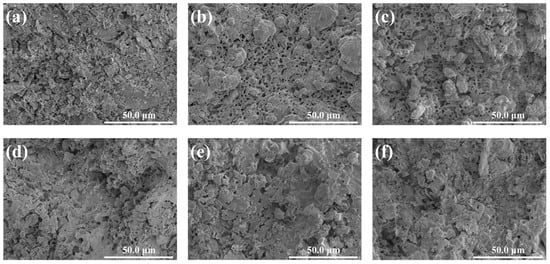
Figure 4.
(a) Surface morphology of untreated ceramics; (b,c) surface morphology of TEOS-treated ceramics; (d) surface morphology of CB-treated wafers; and (e,f) surface morphology of TEOS + CB-treated wafers.
3.2. Colorimetric Analysis
The surface chromaticity of cultural relics must remain visually imperceptible after chemical reagent application with the aim of avoiding irreversible esthetic alterations []. Consequently, colorimetric analysis of untreated and treated ceramics has emerged as a critical aspect. Figure 5 illustrates the portable chromameter employed for color-difference analysis and the corresponding DE* of the samples after undergoing consolidation with TEOS/CB hybrid materials. As demonstrated by DE* measurements in Figure 5b, TEOS reinforcement alone induces noticeable chromatic shifts (DE* = 5–7). However, the ΔE of the samples with 30% and 40% TEOS reinforcement exhibits minimal deviations. This phenomenon correlates with TEOS penetration dynamics; moderately lower concentrations result in surface accumulation that enhances light scattering through refractive index mismatches, while excessively greater concentrations can cause matrix saturation and subsequent surface deposition of unreacted TEOS. These findings confirm that precision dosing of reinforcing agents is imperative for chromatic stability. Significantly, CB reinforcement demonstrates exceptional color preservation, surpassing the threshold of human visual perception. Although both TEOS and CB individually comply with conservation standards, their simultaneous application does not naturally render the optimization of their combination a superfluous one. Figure 5c,d shows that composite reinforcement systems exhibit concentration-dependent chromatic deviations. The sample with 30% TEOS + CB (1) exhibits a negligible color difference (DE* = 1.44) that aligns with relic preservation protocols. This outcome confirms the absence of visually detectable alterations and validates the treatment’s compliance with minimal intervention principles.
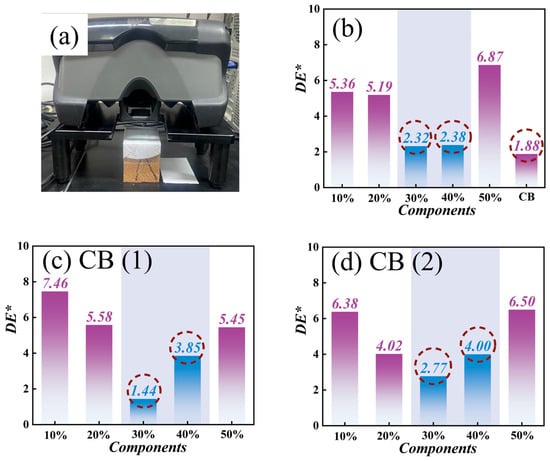
Figure 5.
The experimental test method of colorimetric analysis (a) and DE* in TEOS-doped ceramic samples with varying CB content (b–d).
3.3. Permeability
General permeability tests were evaluated based on penetration velocity and penetration depth. Figure 6 shows the experimental test method of penetration (a) and the high degree of TEOS-doped ceramic samples with different CB contents as a function of time (b–d). In Figure 6a, during the initial penetration phase, the reinforcement material rapidly infiltrated the sample interior, and discernible variations in penetration depth were observed after the first 5 min. Five minutes later, the average penetration depth across all test cases reached 1.0 cm. When the experimental duration was extended to 60 min, the average penetration depth of the reinforcement materials reached 2.5 cm in most cases. As illustrated in Figure 6b–d, the degree of increase over time is high for all samples. A high degree of TEOS-doped ceramic samples presents a scattered curve, indicating that both reaction time and TEOS content have a greater effect on the depth of penetration of the sample, as shown in Figure 6b. High degrees of TEOS-doped ceramic samples with different CB contents show a similar trend as a function of time (Figure 6c,d), suggesting that TEOS-doped ceramic samples are beneficial to the mobility and penetration of the CB reinforcing agent. Comparative analysis of penetration depths confirmed that both reinforcement agents were effectively absorbed into the sample matrices via a two-step process, subsequently initiating measurable physicochemical reactions that contribute to structural consolidation.
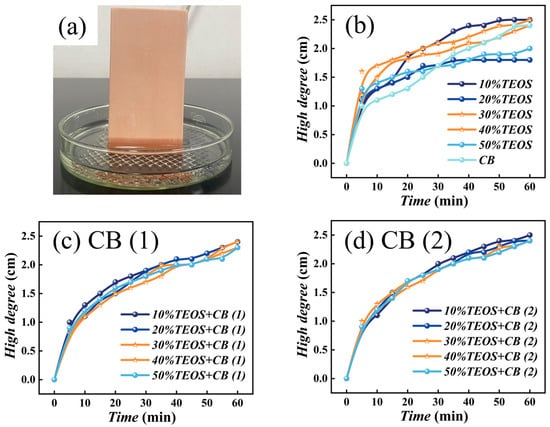
Figure 6.
The experimental test method of penetration (a) and high degree of TEOS doped ceramic samples with different CB contents as a function of time (b–d).
3.4. Breathability Test
Breathability serves as a critical performance indicator in heritage conservation, specifically referring to a material’s ability to allow water vapor transmission under controlled temperature, humidity, and pressure conditions. Higher permeability correlates with increased water vapor mass transfer through the system. Once reinforcement treatments obstruct the internal–external exchange pathways of cultural relics by altering their permeability, “conservation-induced damage” may occur—a paradoxical scenario in which protective interventions exacerbate deterioration. Figure 7 illustrates the experimental test method for air permeability and the mass loss of the samples after mixing with TEOS/CB. Figure 7b demonstrates nearly identical mass loss patterns between TEOS-reinforced and untreated samples, indicating that TEOS treatments preserve vapor transport channels effectively without impeding moisture exchange. In contrast, CB-reinforced specimens exhibit markedly reduced mass loss, indicating that compromised permeability is likely due to particulate clogging. CB particles directly infiltrate and undermine pore structures, thereby restricting vapor diffusion. To reconcile TEOS’s superior permeability with CB’s structural benefits, a novel two-step process was developed in which TEOS initially forms a porous mesh framework on specimen surfaces, and the framework was further augmented by CB-mediated deposition of inorganic mineral ions. Figure 7c,d reveals mass loss of TEOS-doped ceramic samples of different CB contents. With the increase in TEOS + CB content, the mass loss of the ceramic samples initially increases before decreasing. The permeability was found to be improved with the increased reinforcement content of certain formulations (notably 30% and 40% TEOS + CB I in Figure 7c), but excessive dosages (such as TEOS + CB II in Figure 7d) cause significant permeability degradation. Optimal performance was achieved with 30% TEOS + CB I, under which vapor transmission rates were maintained comparable to those with untreated specimens. This equilibrium enables vapor exchange between ceramic matrices and ambient environments, thereby meeting stringent cultural relic preservation standards while mitigating moisture-related deterioration.
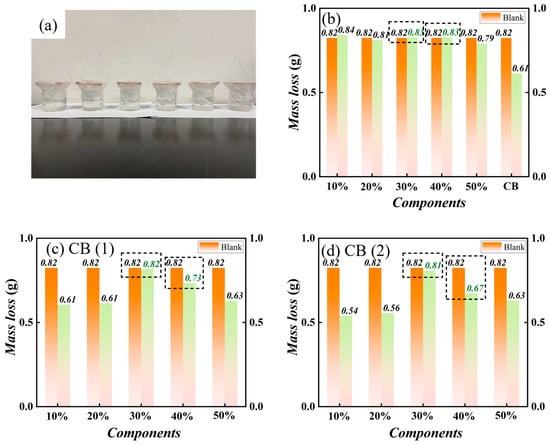
Figure 7.
The experimental test method of breathability test (a) and mass loss in TEOS-doped ceramic samples with varying CB content (b–d).
3.5. Pressure-Resistant Property
Mechanical performance constitutes a key evaluation criterion in cultural relic preservation. Enhancing mechanical performance is essential to halt deterioration processes while maintaining structural integrity, thereby facilitating the long-term preservation of cultural heritage. The mechanical properties of the ceramic samples were tested after mixing with TEOS/CB; the results are shown in Figure 8a. Figure 8b demonstrates that unreinforced specimens exhibited a compressive strength of 4.70 MPa, whereas TEOS-reinforced specimens showed an average strength of 10.00 MPa. Optimal reinforcement ratios were observed at 30% TEOS (9.86 MPa) and 40% TEOS (11.15 MPa), corresponding to 2.10- and 2.37-fold increases over the baseline, respectively. CB-reinforced specimens reached 10.99 MPa, representing a 2.34-fold enhancement. Both reinforcement systems significantly improved the load-bearing capacity of heritage materials. The synergistic effect of TEOS and CB was hypothesized to enhance compressive strength through complementary mechanisms. TEOS provides a silica network for structural stabilization, while CB particles fill micropores to resist stress concentration. As shown in Figure 8c,d, TEOS + CB composites achieved compressive strengths exceeding 10 MPa. The 30%–40% TEOS + CB I formulation produced an average strength of 15.00 MPa. Statistical analysis of the reinforcement dosage–response relationships revealed that the TEOS-CB hybrid system outperformed individual components by 28%–41% in strength enhancement. These results validate the hybrid approach as a scientifically robust strategy for meeting the mechanical requirements of heritage conservation.
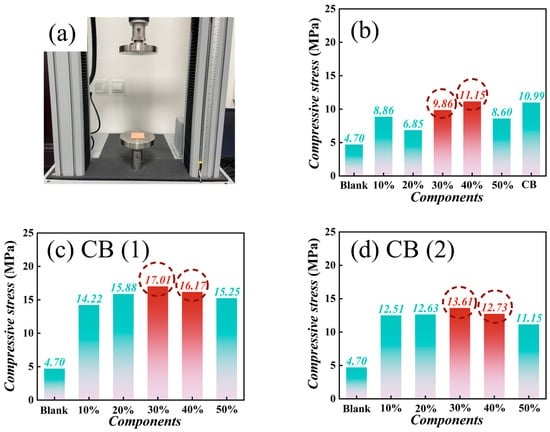
Figure 8.
The experimental test method of pressure-resistant property (a) and compressive stress in TEOS-doped ceramic samples with varying CB content (b–d).
3.6. Bending Resistance
Bending resistance, as a critical indicator for examining the mechanical properties of cultural relics, reflects their ability to withstand deformation under external forces. Cultural relics exposed to natural environments are prone to various forms of degradation, including physical and chemical weathering. These processes induce bending, cracking, elongation, and other structural changes, thereby compromising the preservation of their original appearance. Enhancing the bending resistance of cultural relics is therefore a key objective in their protection and reinforcement. Figure 9a demonstrates the bending test method. The change in mechanical properties of the samples was tested after mixing with TEOS/CB. In Figure 9b, the average flexural strength of TEOS-reinforced samples exceeded 2.0 MPa, representing a two-fold increase compared to the original samples. The optimal reinforcement ratios for maximizing flexural strength were identified as 30% TEOS and 40% TEOS, yielding values of 2.56 MPa and 2.55 MPa, respectively. In contrast, CB-reinforced samples achieved only 1.97 MPa in flexural strength, indicating minimal improvement and suggesting that CB alone inadequately enhances torsional properties. This underscores the necessity of TEOS pretreatment to optimize CB’s effectiveness. Figure 9c,d demonstrates that the TEOS + CB combination significantly improves flexural strength, compensating for the limitations of the sole use of CB. All composite-reinforced samples exhibited an average flexural strength above 2.20 MPa. Notably, the 30% and 40% TEOS + CB combinations achieved the highest performance, with specific configurations (labeled as 30% TEOS + CB II and 40% TEOS + CB II in Figure 9d) reaching 2.76 MPa and 2.91 MPa, respectively. These results confirm that TEOS synergizes with CB to substantially enhance the bending resistance of artifacts, thereby improving their durability in natural environments and preserving their original integrity.
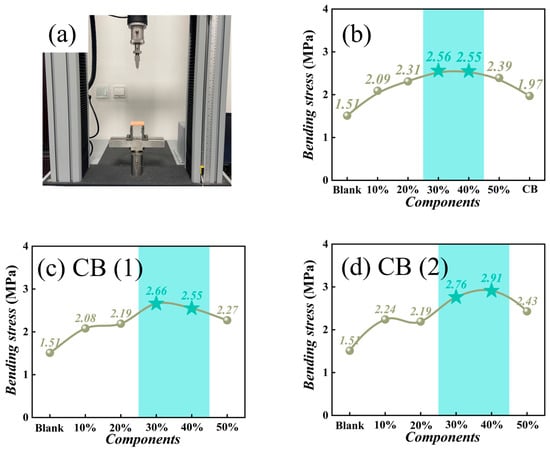
Figure 9.
The experimental test method of bending resistance (a) and bending stress in TEOS-doped ceramic samples with varying CB content (b–d).
Based on the above research, composites with different ratios of TEOS, CB, and TEOS + CB were systematically prepared to evaluate the reinforcement performances for ceramic samples. A comprehensive analysis reveals that TEOS, as an organic material, utilizes its Si-O-Si chemical bonding to penetrate the ceramic clay’s interior, forming a mesh structure that supports the internal framework. Additionally, the inorganic material CB is introduced to generate inorganic salt precipitates (such as BaCO3, CaC2O4, and Ba3(PO4)2) through reactions with internal ions. Ultimately, the synergistic effect of TEOS + CB composites significantly enhances the intrinsic properties of the pottery, including mechanical strength, color stability, and gas permeability, as illustrated in Figure 10. The outstanding comprehensive reinforced properties, including 30% TEOS + CB I, were obtained in the ceramic samples, as shown in Figure 11, with features such as low color difference (DE*), high penetration depths, optimal air permeability, and enhanced mechanical performance. Moreover, the mechanical strength and ΔE of the reinforcing agents in this study are higher than those of any other reinforcing agents, as shown in Figure 12 [,,,,,,,,,].
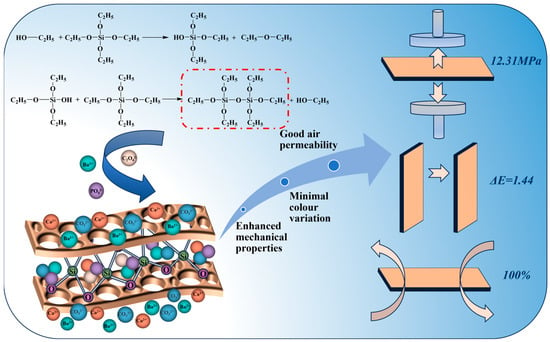
Figure 10.
Mechanism of action of reinforcement in the interior of ceramic tile samples.
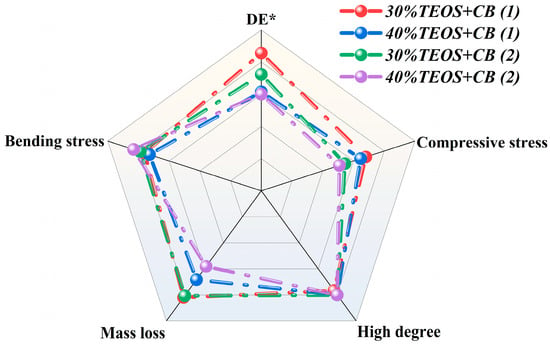
Figure 11.
Comparison of the performance of the best components.
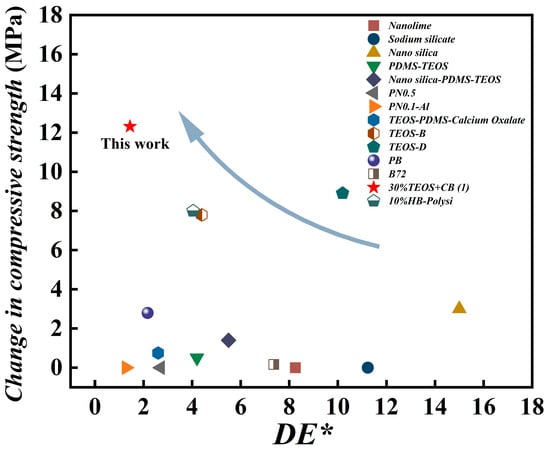
Figure 12.
Performance comparison of common reinforcement materials.
4. Conclusions
A new reinforcement technology for composite reinforcement materials, utilizing TEOS as an organic material and CB as an inorganic material, by means of a two-step process, is reported. XRD analyses and scanning electron microscopy images show that neither TEOS nor CB reinforcements alter the intrinsic material structure of the pottery. Gas permeability tests indicate that TEOS + CB composites do not significantly affect gas flow through the vitrified clay, suggesting that pore connectivity is preserved. In terms of mechanical properties, TEOS + CB composites show excellent reinforcement efficiency, achieving an optimal compromise between interfacial bond strength and pore protection. Penetration tests show that the TEOS + CB composite can be effectively absorbed by the ceramic with an average penetration depth of 2.4 cm. Significantly, the TEOS-CB hybrid composite exhibits optimal color stability with a DE* of 2.1 ± 0.4. This hybrid system’s potential for integrating structural reinforcement with chromatic fidelity aligns with the dual objectives of contemporary heritage conservation: mechanical stabilization and esthetic preservation. In conclusion, the TEOS + CB composite demonstrated multifaceted conservation efficacy. This material offers practical advantages, including facile preparation, cost-effectiveness, and material accessibility, implying its potential for ceramic artifact conservation.
Author Contributions
Conceptualization: Y.L.; methodology: T.T.; validation: X.S. and R.C.; investigation: T.T.; resources: N.X., S.S., Z.J., Y.Z., H.X. and X.C.; writing—original draft preparation: T.T.; writing—review and editing: Z.P., Y.L. and X.C.; supervision: N.X., X.S., Z.P., S.S., Z.J., Y.Z., H.X., Y.L. and X.C.; project administration: R.C. All authors have read and agreed to the published version of the manuscript.
Funding
This study received no external funding support.
Institutional Review Board Statement
Not applicable.
Informed Consent Statement
Not applicable.
Data Availability Statement
The datasets used and analyzed during the current study are available from Tao Tan (taotan@snnu.edu.cn) on reasonable request.
Acknowledgments
We extend our sincere gratitude to the students and teachers who participated in the experiment.
Conflicts of Interest
The authors declare no conflicts of interest.
References
- Mohamed, H.M. A Comparison Study of Titanium Dioxide and Zinc Oxide Nanoparticles for Cleaning Archaeological Pottery. J. Nano Res. 2022, 76, 61–77. [Google Scholar] [CrossRef]
- Maggetti, M. Archaeometric Analyses of European 18th–20th Century White Earthenware—A Review. Minerals 2018, 8, 269. [Google Scholar] [CrossRef]
- Stefanidou, M.; Karozou, A. Testing the effectiveness of protective coatings on traditional bricks. Constr. Build. Mater. 2016, 111, 482–487. [Google Scholar] [CrossRef]
- David, M.E.; Ion, R.-M.; Grigorescu, R.M.; Iancu, L.; Andrei, E.R. Nanomaterials Used in Conservation and Restoration of Cultural Heritage: An Up-to-Date Overview. Materials 2020, 13, 2064. [Google Scholar] [CrossRef] [PubMed]
- Ricca, M.; Cámara, B.; Fort, R.; de Buergo, M.A.; Randazzo, L.; Petriaggi, B.D.; La Russa, M.F. Definition of analytical cleaning procedures for archaeological pottery from underwater environments: The case study of samples from Baia (Naples, South Italy). Mater. Des. 2021, 197, 109278. [Google Scholar] [CrossRef]
- Li, Y.; Guo, H.; Xiao, K.; Liu, P.; Chao, X.; Fu, P.; Xing, H.; Li, Y. A Study of Pigment, Adhesive, and Firing Temperature in Pottery Figurines Excavated from the Tomb of Qibi Ming, China. Molecules 2023, 28, 7739. [Google Scholar] [CrossRef]
- Mohamed, H.M.; Mohamed, W.S. Evaluating nano Primal AC33 for protection and consolidation processes of archaeological pottery: A comparison study with silica and montmorillonite nanoparticles. Pigment Resin Technol. 2024, 53, 484–492. [Google Scholar] [CrossRef]
- Cultrone, G.; Sebastián, E.; Elert, K.; de la Torre, M.J.; Cazalla, O.; Rodriguez–Navarro, C. Influence of mineralogy and firing temperature on the porosity of bricks. J. Eur. Ceram. Soc. 2004, 24, 547–564. [Google Scholar] [CrossRef]
- Bruni, S.; Longoni, M.; De Filippi, F.; Calore, N.; Bagnasco Gianni, G. External Reflection FTIR Spectroscopy Applied to Archaeological Pottery: A Non-Invasive Investigation about Provenance and Firing Temperature. Minerals 2023, 13, 1211. [Google Scholar] [CrossRef]
- Daniele, V.; Taglieri, G.; Quaresima, R. The nanolimes in Cultural Heritage conservation: Characterisation and analysis of the carbonatation process. J. Cult. Herit. 2008, 9, 294–301. [Google Scholar] [CrossRef]
- Dei, L.; Salvadori, B. Nanotechnology in cultural heritage conservation: Nanometric slaked lime saves architectonic and artistic surfaces from decay. J. Cult. Herit. 2006, 7, 110–115. [Google Scholar] [CrossRef]
- Zornoza-Indart, A.; López-Arce, P.; López-Polín, L. Durability of traditional and new nanoparticle based consolidating products for the treatment of archaeological stone tools: Chert artifacts from Atapuerca sites (Burgos, Spain). J. Cult. Herit. 2017, 24, 9–21. [Google Scholar] [CrossRef]
- Franzoni, E.; Graziani, G.; Sassoni, E.; Bacilieri, G.; Griffa, M.; Lura, P. Solvent-based ethyl silicate for stone consolidation: Influence of the application technique on penetration depth, efficacy and pore occlusion. Mater. Struct. 2014, 48, 3503–3515. [Google Scholar] [CrossRef]
- Sierra-Fernandez, A.; Gomez-Villalba, L.S.; Rabanal, M.E.; Fort, R. New nanomaterials for applications in conservation and restoration of stony materials: A review. Mater. Constr. 2017, 67, e107. [Google Scholar] [CrossRef]
- Ricciotti, L.; Occhicone, A.; Ferone, C.; Cioffi, R.; Tarallo, O.; Roviello, G. Development of Geopolymer-Based Materials with Ceramic Waste for Artistic and Restoration Applications. Materials 2022, 15, 8600. [Google Scholar] [CrossRef]
- Bonazza, A.; Vidorni, G.; Natali, I.; Ciantelli, C.; Giosuè, C.; Tittarelli, F. Durability assessment to environmental impact of nano-structured consolidants on Carrara marble by field exposure tests. Sci. Total Environ. 2017, 575, 23–32. [Google Scholar] [CrossRef]
- Fistos, T.; Fierascu, I.; Doni, M.; Chican, I.E.; Fierascu, R.C. A Short Overview of Recent Developments in the Application of Polymeric Materials for the Conservation of Stone Cultural Heritage Elements. Materials 2022, 15, 6294. [Google Scholar] [CrossRef]
- Ikeoka, R.A.; Appoloni, C.R.; Scorzelli, R.B.; dos Santos, E.; Rizzutto, M.d.A.; Bandeira, A.M. Study of Ancient Pottery from the Brazilian Amazon Coast by EDXRF, PIXE, XRD, Mössbauer Spectroscopy and Computed Radiography. Minerals 2022, 12, 1302. [Google Scholar] [CrossRef]
- Liu, Y.; Liu, J. Synthesis of TEOS/PDMS-OH/CTAB composite coating material as a new stone consolidant formulation. Constr. Build. Mater. 2016, 122, 90–94. [Google Scholar] [CrossRef]
- Drelich, A.; Miller, J.; Donofrio, R.; Drelich, J. Novel Durable Antimicrobial Ceramic with Embedded Copper Sub-Microparticles for a Steady-State Release of Copper Ions. Materials 2017, 10, 775. [Google Scholar] [CrossRef]
- Zendri, E.; Biscontin, G.; Nardini, I.; Riato, S. Characterization and reactivity of silicatic consolidants. Constr. Build. Mater. 2007, 21, 1098–1106. [Google Scholar] [CrossRef]
- Ion, R.-M.; Pungoi, A.-E.; Iancu, L.; Grigorescu, R.M.; Vasilievici, G.; Gheboianu, A.I.; Slamnoiu-Teodorescu, S.; Alexandrescu, E. Compositional and Microstructural Investigations of Prehistoric Ceramics from Southern Romania (Middle Neolithic Pottery). Appl. Sci. 2024, 14, 5755. [Google Scholar] [CrossRef]
- Ferreira Pinto, A.P.; Delgado Rodrigues, J. Impacts of consolidation procedures on colour and absorption kinetics of carbonate stones. Stud. Conserv. 2014, 59, 79–90. [Google Scholar] [CrossRef]
- Cultrone, G.; Sanchez-Ibanez, V. Consolidation with ethyl silicate: How the amount of product alters the physical properties of the bricks and affects their durability. Mater. Constr. 2018, 68, 173. [Google Scholar] [CrossRef]
- Hu, X.; Lai, Y.; Hu, Y.; Li, Y.; Zhao, D.; Tong, F. Research on the Application of Polymer Materials in Contemporary Ceramic Art Creation. Polymers 2022, 14, 552. [Google Scholar] [CrossRef] [PubMed]
- Xu, Y.; Yin, H.; Yuan, S.; Chen, Z. Film morphology and orientation of amino silicone adsorbed onto cellulose substrate. Appl. Surf. Sci. 2009, 225, 8435–8442. [Google Scholar] [CrossRef]
- He, W.; Zhang, Z.; Zheng, Y.; Qiao, S.; Xie, Y.; Sun, Y.; Qiao, K.; Feng, Z.; Wang, X.; Wang, J. Preparation of aminoalkyl-grafted bacterial cellulose membranes with improved antimicrobial properties for biomedical applications. J. Biomed. Mater. Res. Part A 2020, 108, 1086–1098. [Google Scholar] [CrossRef] [PubMed]
- Licchelli, M.; Malagodi, M.; Weththimuni, M.; Zanchi, C. Nanoparticles for conservation of bio-calcarenite stone. Appl. Phys. A 2013, 114, 673–683. [Google Scholar] [CrossRef]
- Chelazzi, D.; Poggi, G.; Jaidar, Y.; Toccafondi, N.; Giorgi, R.; Baglioni, P. Hydroxide nanoparticles for cultural heritage: Consolidation and protection of wall paintings and carbonate materials. J. Colloid Interface Sci. 2012, 392, 42–49. [Google Scholar] [CrossRef]
- Giorgi, R.; Ambrosi, M.; Toccafondi, N.; Baglioni, P. Nanoparticles for Cultural Heritage Conservation: Calcium and Barium Hydroxide Nanoparticles for Wall Painting Consolidation. Chem.-A Eur. J. 2010, 16, 9374–9382. [Google Scholar] [CrossRef]
- Yan, J.C.; Huang, G.; Li, X.N.; Liu, Q.; Liu, Y.; Yang, F.W.; Zhang, K.; Sun, Y.C. A comparative study between aqueous and methanol solutions of barium hydroxide: Implications for applying barium protectants in gypsification calcareous relics. Herit. Sci. 2024, 12, 203. [Google Scholar] [CrossRef]
- Lu, R.C.; Wang, L.; Liu, Y.; Yang, F.W.; Yang, L.; Wang, L.Q.; Gao, X. Conservation of surface gypsification stone relics using methanol solution of barium hydroxide as a novel treating agent. Appl. Phys. A-Mater. Sci. Process. 2022, 128, 37. [Google Scholar] [CrossRef]
- Bourguignon, E.; Tomasin, P.; Detalle, V.; Vallet, J.-M.; Labouré, M.; Olteanu, I.; Favaro, M.; Chiurato, M.A.; Bernardi, A.; Becherini, F. Calcium alkoxides as alternative consolidants for wall paintings: Evaluation of their performance in laboratory and on site, on model and original samples, in comparison to conventional products. J. Cult. Herit. 2018, 29, 54–66. [Google Scholar] [CrossRef]
- Ibrahim, M.M.; Mohamed, S.O.; Hefni, Y.K.; Ahmed, A.I. Nanomaterials for Consolidation and Protection of Egyptian Faience Form Matteria, Egypt. J. Nano Res. 2019, 56, 39–48. [Google Scholar] [CrossRef]
- Rodrigues, J.D.; Grossi, A. Indicators and ratings for the compatibility assessment of conservation actions. J. Cult. Herit. 2007, 8, 32–43. [Google Scholar] [CrossRef]
- Graziani, G.; Sassoni, E.; Franzoni, E. Consolidation of porous carbonate stones by an innovative phosphate treatment: Mechanical strengthening and physical-microstructural compatibility in comparison with TEOS-based treatments. Herit. Sci. 2015, 3, 1–6. [Google Scholar] [CrossRef]
- Rong, Y.; Yang, J.; Huang, S.; Li, Y. Barium Hydroxide Nanoparticle–Phosphoric Acid System for Desalination and Consolidation of Tomb Murals. Crystals 2022, 12, 1171. [Google Scholar] [CrossRef]
- Franzoni, E.; Pigino, B.; Leemann, A.; Lura, P. Use of TEOS for fired-clay bricks consolidation. Mater. Struct. 2013, 47, 1175–1184. [Google Scholar] [CrossRef]
- Maravelaki, P.-N.; Kapetanaki, K.; Stefanakis, D. TEOS-PDMS-Calcium Oxalate Hydrophobic Nanocomposite for Protection and Stone Consolidation. Heritage 2021, 4, 4068–4075. [Google Scholar] [CrossRef]
- Wang, Y.; Wang, W.; Yang, X.; Xu, S. New method for the protection of calcareous cultural heritage stones by aluminium phosphate modified hydroxyapatite. Constr. Build. Mater. 2024, 431, 136551. [Google Scholar] [CrossRef]
- Liu, R.; Han, X.; Huang, X.; Li, W.; Luo, H. Preparation of three-component TEOS-based composites for stone conservation by sol–gel process. J. Sol-Gel Sci. Technol. 2013, 68, 19–30. [Google Scholar] [CrossRef]
- Navarro-Moreno, D.; Martínez-Arredondo, A.; García-Vera, V.E.; Lourdes Gutiérrez-Carrillo, M.; Antonio Madrid, J.; Lanzón, M. Nanolime, ethyl silicate and sodium silicate: Advantages and inconveniences in consolidating ancient bricks (XII–XIII century). Constr. Build. Mater. 2021, 277, 122240. [Google Scholar] [CrossRef]
- Zhao, G.; Ma, X.; Shao, Z.; Huang, X.; Huang, J.; Luo, H. Breathable hyperbranched polysiloxane for the conservation of silicate cultural heritages. J. Sol-Gel Sci. Technol. 2022, 106, 518–529. [Google Scholar] [CrossRef]
- Xu, Q.; Zhou, H.; Huang, X.; Zhao, X.; Huang, J.; Luo, H. In-situ formation of one-dimensional silica for conservation of silicate relics using cellulose nanocrystals as templates. J. Cult. Herit. 2023, 62, 349–355. [Google Scholar] [CrossRef]
- Ilieș, D.C.; Apopei, A.-I.; Ilieș, A.; Caciora, T.; Zharas, B.; Hodor, N.; Turza, A.; Hassan, T.H.; Barbu-Tudoran, L.; Pereș, A.C.; et al. Preserving Cultural Heritage: Enhancing Limestone Durability with Nano-TiO2 Coating. Heritage 2024, 7, 4914–4932. [Google Scholar] [CrossRef]
Disclaimer/Publisher’s Note: The statements, opinions and data contained in all publications are solely those of the individual author(s) and contributor(s) and not of MDPI and/or the editor(s). MDPI and/or the editor(s) disclaim responsibility for any injury to people or property resulting from any ideas, methods, instructions or products referred to in the content. |
© 2025 by the authors. Licensee MDPI, Basel, Switzerland. This article is an open access article distributed under the terms and conditions of the Creative Commons Attribution (CC BY) license (https://creativecommons.org/licenses/by/4.0/).